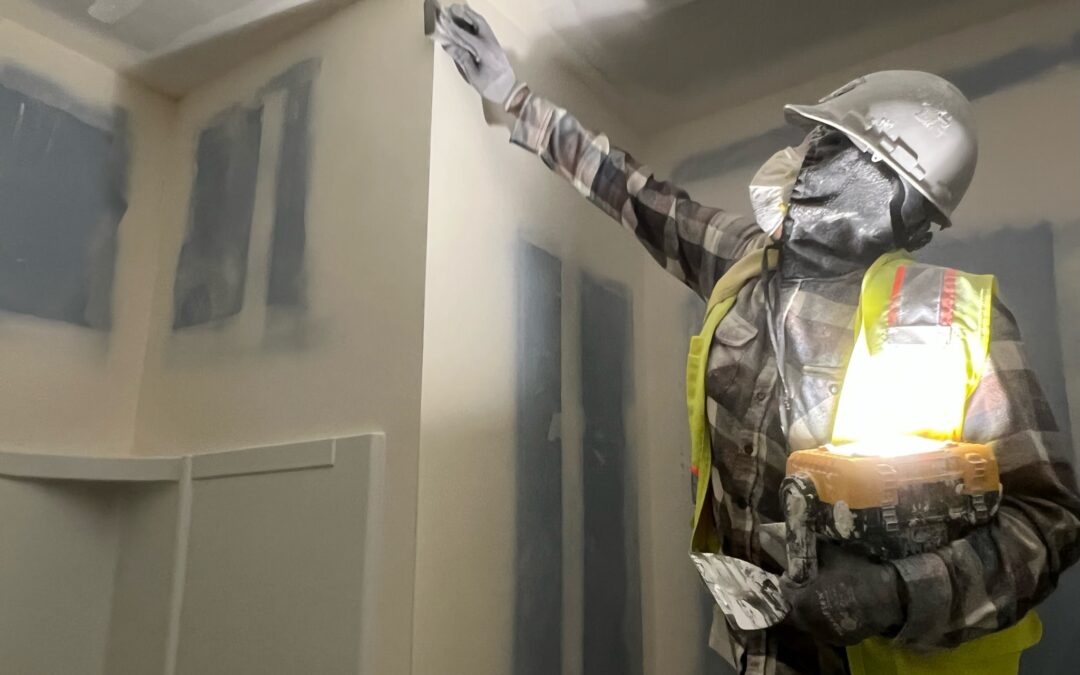What is plaster? It is a building material that has been used for centuries, that dates as far back as Ancient Egypt, and is still used today.
While drywall is usually the main choice for wall construction these days, plaster is still a good building material that can work better for drywall in certain cases. Whether you are having an older commercial building restored or just need some light remodeling work, there is the potential that plaster is the right choice for your project. In this article, we will look at everything you need to know about what plaster is, its uses, and more.
What is plaster?
Plaster has been used in construction since ancient times, but the process has evolved over the centuries to improve it. Plaster is great for creating a smooth and polished wall that is durable. Plaster is made of a combination of lime or cement, sand, and water, which is applied to the walls and has to dry. The exact formula for the plaster will vary depending on its use and the environment around it, but it provides a seamless finish that can conceal bricks, concrete, and other building materials. It is a highly durable material, so durable that you cannot hammer a nail into it to hang something — which is important to keep in mind if you plan to put up shelves or hang pictures in your commercial building.
The Different Types of Plaster
Since there are a few ways to make plaster, depending on what it is being used for, it is important to know the differences between each of the different types of plaster.
Gypsum Plaster
Gypsum plaster is the main type of plaster used in modern construction these days. It is made of a calcium sulfate dihydrate that is mixed with water. Once it is mixed, it has to be applied quickly to prevent the plaster from forming weak areas. This does not breathe as well as other types of plaster, so gypsum plaster is not suitable for a room with higher humidity, like a bathroom or kitchen. Gypsum plaster is great for interior walls in a building that are not high humidity.
Lime Plaster
Lime plaster is essentially the original type of plaster. It is made of lime, sand, and water. When it was first invented, horse hair was sometimes used as a binder, so in a building built before the 1900s, it’s likely that you’ll notice some strands of hair in the plaster walls. Lime is a breathable and flexible type of plaster, so moisture is not likely to get trapped in it, making it a good choice for bathroom or kitchen walls. Since it is flexible, it is less likely to crack as the building settles over time.
It is usually a little more expensive than some other types of plaster, and it takes longer to apply, so you are looking at a higher labor cost. Lime plaster is best for restoring older buildings and giving them a classic look.
Cement Plaster
Cement plaster is made up of cement and sand. It is thick and usually a pretty quick setting, so it has to be applied quickly once it has been mixed. It is good for both interior and exterior walls, but it usually has a pretty rough finish, so if you want a completely smooth wall, it is not the right choice for you. Cement plaster is not as breathable or flexible as lime or gypsum plaster, so the best use for it is on exterior walls.
Clay Plaster
Clay plaster combines clay with sand and water. The unique thing about clay plaster is that you can add pigments into the mix, so you will not need to paint the walls when the plaster is set. Clay plaster creates a rustic look when finished. However, it is important to keep in mind that clay can absorb water easily, so this type of plaster is the worst for a bathroom, kitchen, or even an exterior wall.
Common Questions About Plaster
Now that you know a little more about what plaster is and the types of plaster out there, let’s take a look at some frequently asked questions about plaster.
What is the most durable type of plaster?
Lime plaster is the most flexible and breathable type of plaster, making it the most durable. It also is more fire-resistant than other plaster types.
Why should I use plaster over drywall?
Drywall can be more affordable than plaster, but plaster has a different design aesthetic that might appeal to you more than the look drywall creates. Plaster can last longer than drywall, and it can be more energy efficient.
Further reading: Should I Get Plaster or Drywall?
Can you mix different plaster types?
While you can mix different types of plaster, it is not recommended to do so. For example, you might want to put lime plaster on top of gypsum plaster, but doing so can potentially affect the breathability of the lime plaster and impact its performance.
Can I install or repair plaster by myself?
Technically, yes, you can DIY plaster repairs or installation, but this is a material that is better installed by professionals. You want the walls of your commercial building to look great, and the best way to do that is to hire a team of experts to complete your plaster work for you.
Final Thoughts
Plaster is a highly durable building material that can stand up to time and give your commercial building some beautiful, smooth walls. If you are interested in having plaster walls installed or need any other construction work completed, contact Magnum today! We are the experts in plaster in the San Francisco Bay Area.


